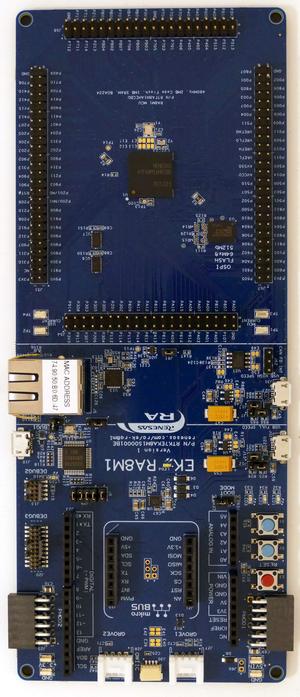Difference between revisions of "Renesas RA8M1"
(Created page with "The '''Renesas RA8M1''' are Cortex-M85 based microcontrollers. __TOC__ {{Renesas RA8}} ==Evaluation Boards== Renesas EK-RA8M1 evaluation board: http://wiki.segger.com/Renesa...") |
SebastianB (talk | contribs) |
||
| Line 9: | Line 9: | ||
==Example Application== |
==Example Application== |
||
Renesas EK-RA8M1 evaluation board: http://wiki.segger.com/Renesas_EK-RA8M1#Example_Project |
Renesas EK-RA8M1 evaluation board: http://wiki.segger.com/Renesas_EK-RA8M1#Example_Project |
||
| + | |||
| + | == Tracing on RA8M1 series == |
||
| + | === Tracing on R7FA8M1 === |
||
| + | ==== Minimum requirements ==== |
||
| + | In order to use trace on the Renesas R7FA8M1 MCU devices, the following minimum requirements have to be met: |
||
| + | * J-Link software version V7.92I or later |
||
| + | * Ozone V3.30c or later (if streaming trace and / or the sample project from below shall be used) |
||
| + | * SEGGER Embedded Studio V7.32 |
||
| + | * J-Trace PRO for Cortex-M HW version V3.0 or later for streaming trace |
||
| + | * J-Link Plus V12 or later for TMC/ETB trace |
||
| + | To rebuild the project our IDE Embedded Studio can be used. The recommended version to rebuild the projects is V7.32. But the examples are all prebuild and work out-of-the box with Ozone, so rebuilding is not necessary. |
||
| + | |||
| + | ==== Streaming trace ==== |
||
| + | The project has been tested with the minimum requirements mentioned above and a ''Renesas EK-RA8M1''. |
||
| + | |||
| + | '''Example project:''' [[Media:Renesas_RA8_TracePins.zip | Renesas_RA8_TracePins.zip]] |
||
| + | |||
| + | '''Note:''' The example is shipped with a compiled .JLinkScriptfile, should you need the original source, please get in touch with SEGGER directly via our support system: https://www.segger.com/ticket/. |
||
| + | |||
| + | To create your own .JLinkScriptfile you can use the following guide as reference: [[How_to_configure_JLinkScript_files_to_enable_tracing]] |
||
| + | |||
| + | ==== Trace buffer (TMC/ETB) ==== |
||
| + | '''Example Project:''' [[Media:Renesas_RA8_TraceBuffer.zip | Renesas_RA8_TraceBuffer.zip]] |
||
| + | |||
| + | ==== Tested Hardware ==== |
||
| + | [[File:Renesas_EK-RA8M1.jpg|none|thumb|Renesas EK-RA8M1 evaluation board]] |
||
Revision as of 15:55, 26 October 2023
The Renesas RA8M1 are Cortex-M85 based microcontrollers.
Contents
Flash Banks
Internal Flash
| Flash Bank | Base address | Size | J-Link Support | Loaders |
|---|---|---|---|---|
| Code flash option-setting memory (secure) | 0x0300A100 | 384 B |
| |
| Code flash option-setting memory (non-secure) | 0x1300A180 | 128 B |
| |
| Data flash option-setting memory | 0x27030080 | 720 B |
| |
| Code flash (secure) | 0x02000000 | Up to 2048 KB |
| |
| Code flash (non-secure) | 0x12000000 | Up to 2048 KB |
| |
| Data flash (secure) | 0x27000000 | Up to 12 KB |
| |
| Data flash (non-secure) | 0x37000000 | Up to 12 KB |
|
QSPI Flash
QSPI flash programming requires special handling compared to internal flash. For more information about this, please see the QSPI Flash Programming Support article.
Flash programming in OSPI mode is supported for Infineon S28HL512T and S28HS512T only. Other flashes are handled in single/quad mode.
| Bank name | Base address | Maximum size | Supported pin configuration |
|---|---|---|---|
| External OSPI flash CS0 | 0x80000000 | 256 MB |
|
| External OSPI flash CS1 | 0x90000000 | 256 MB |
|
Watchdog Handling
- The device has two watchdogs: Watchdog Timer (WDT) and Independent Watchdog Timer (IWDT).
- Both watchdogs are fed during flash programming.
Device Specific Handling
Connect
During connect the current security state of the device is determined. Depending on the state J-Link will use different RAM areas for operations that require RAM (flash programming, clock speed measurements):
- OEM_PL2: 0x22000000-0x2200FFFF
- OEM_PL1: 0x320D0000-0x320DFFFF
Reset
- The devices uses normal Cortex-M reset, no special handling necessary, like described here.
Limitations
Using OEM_PL1 state with J-Flash
Since OEM_PL1 state requires the use of non-secure RAM (0x320D0000-0x320DFFFF), the user has to ensure that the J-Flash project is set up to use this RAM area instead of the secure RAM. By default J-Flash projects are created with secure RAM area (0x22000000-0x2200FFFF) selected.
Evaluation Boards
Renesas EK-RA8M1 evaluation board: http://wiki.segger.com/Renesas_EK-RA8M1
Example Application
Renesas EK-RA8M1 evaluation board: http://wiki.segger.com/Renesas_EK-RA8M1#Example_Project
Tracing on RA8M1 series
Tracing on R7FA8M1
Minimum requirements
In order to use trace on the Renesas R7FA8M1 MCU devices, the following minimum requirements have to be met:
- J-Link software version V7.92I or later
- Ozone V3.30c or later (if streaming trace and / or the sample project from below shall be used)
- SEGGER Embedded Studio V7.32
- J-Trace PRO for Cortex-M HW version V3.0 or later for streaming trace
- J-Link Plus V12 or later for TMC/ETB trace
To rebuild the project our IDE Embedded Studio can be used. The recommended version to rebuild the projects is V7.32. But the examples are all prebuild and work out-of-the box with Ozone, so rebuilding is not necessary.
Streaming trace
The project has been tested with the minimum requirements mentioned above and a Renesas EK-RA8M1.
Example project: Renesas_RA8_TracePins.zip
Note: The example is shipped with a compiled .JLinkScriptfile, should you need the original source, please get in touch with SEGGER directly via our support system: https://www.segger.com/ticket/.
To create your own .JLinkScriptfile you can use the following guide as reference: How_to_configure_JLinkScript_files_to_enable_tracing
Trace buffer (TMC/ETB)
Example Project: Renesas_RA8_TraceBuffer.zip
